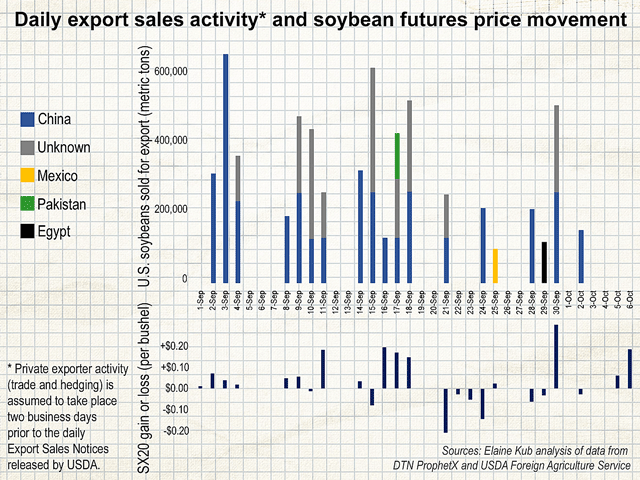Kub's Den
Soybean Bullishness: Be Fearful When Others Are Greedy
There's only one thing that can take the fun out of selling $10 soybeans across the scale at harvest: Convincing yourself the soybean market is so overwhelmingly bullish that it definitely ought to be headed toward $11, $12, the moon!
There are certainly enough people out there who will make that case for you, on farm media panel shows or getting coffee at the local convenience store. "Look at exports," they'll say, "Look at the derecho damage. Look at how tight the ending stocks will be; $10.50 futures isn't a selling opportunity -- it's a buying opportunity! Once you sell the physical beans, and you've got that storage risk, basis risk and price risk off your balance sheet, why don't you turn back around and pay your broker some commissions to go long again with that same price risk in futures contracts?"
From a fundamental market perspective, I can't help but agree that the balance of U.S. soybean supply and demand looks truly bullish. On 20 of the past 25 trading days, there have been announcements of huge soybean export sales, usually to China or unknown, averaging 335,000 metric tons (mt) per day (12 million bushels per day). The quarterly grain stocks report showed there are only 58% as many soybeans left in the country compared to this time last year. Implications from the revised understanding of 2019 soybean production and the current pace of demand suggests that, at the end of this new 2020-21 marketing year, soybean ending stocks will be lower than 460 million bushels (mb) and potentially lower than 10% of total usage (4.4 billion bushels). Stay tuned for Friday's release of the latest World Agricultural Supply and Demand Estimates (WASDE).
P[L1] D[0x0] M[300x250] OOP[F] ADUNIT[] T[]
But is the bulk of this bullishness, as legitimate as it may be, now behind us? The November soybean futures contract has rallied more than $1.50 per bushel since the start of August, with 22 cents of that on Tuesday alone. Bursts of export sales business have been the engine behind this climb. When a commercial trading firm sells physical soybeans, they remain price neutral by hedging each sale -- buying futures exposure on the same day as the cash sale was negotiated (short cash; long futures). For instance, a 132,000 mt forward cash sales contract to a Chinese trading firm requires a hedge of 970 long futures contracts. That's the direct mechanism that leads futures prices higher on the days when export sales take place.
Then, if the sale is larger than 100,000 mt, the exporter is required to report the sale to USDA by 3:00 p.m. Eastern time on the next business day following the sale. Then, USDA compiles those private exporter reports and releases them to the public at 9 a.m. Eastern time on the day after that. Therefore, it's likely two days after each big sale that it becomes officially known by the broader market, working into traders' sentiments and outlooks. In this case, the big export sales announcements get bullish traders salivating about how much higher the market could go, and they then presumably join in the futures-buying spree after the fact.
Discretionary traders motivated by past market movements should be careful. "Everything in our bodies conspires to make us do the wrong thing -- get more excited and optimistic the higher things go and more depressed and pessimistic the lower things go," according to Howard S. Marks, co-chairman of Oaktree Capital Management. That quote reminds me of a pithier saying from Warren Buffet: "Be fearful when others are greedy and greedy when others are fearful."
What would "fearfulness" look like during this stage of the bullish soybean rally? Perhaps we should start thinking about what could go wrong. Approximately 18% of the 99 million metric tons (mmt) that China is ultimately projected to purchase from the United States in the 2020-21 marketing year have already been put on the books and it's unlikely the rapid pace of September export sales will last forever ... certainly not past February when the new-crop South American soybean supply becomes available. Brazil's wet season is forecast to start next week, and their planted soybean acreage is expected to be record large due to these highly motivating global soybean prices.
Meanwhile, of course, there is always potential for outside market volatility in the month leading up to a hotly contested U.S. presidential election. Total open interest in soybean futures is larger now than it has ever been, at over one million contracts, but if investors get spooked away from "risky" assets for any reason, they are hugely overweighted toward bullish long positions and could be quick to sell off those speculations. It hasn't happened yet, and may not happen in the near future, but that's the kind of moment -- when the "consensus" turns fearful -- when buying might make more sense.
Elaine Kub is the author of "Mastering the Grain Markets: How Profits Are Really Made" and can be reached at masteringthegrainmarkets@gmail.com or on Twitter @elainekub.
(c) Copyright 2020 DTN, LLC. All rights reserved.




